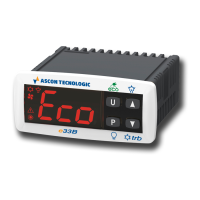
Do you have a question about the Ascon tecnologic e33B and is the answer not in the manual?
| Protection Class | IP65 (front) |
|---|---|
| Supply voltage | 24 V AC/DC |
| Input | Thermocouple, RTD |
| Output | Relay, SSR |
| Control mode | PID, On/Off |
| Control Algorithm | PID |
| Display | LED |
| Operating temperature | 0°C to 50°C |
| Mounting | Panel mounting |
| Communication | No |
Overview of the microprocessor-based digital electronic temperature controller model e33B and its primary applications.
Details the components and layout of the instrument's front panel, including keys and status LEDs.
Sets the regulation Set Point using parameters EEd=1 or EEd=2 for quick and easy adjustment.
Procedure to access and modify instrument parameters when password protection is disabled.
Enables setting a password to protect instrument parameters from unauthorized changes.
Allows selective parameter accessibility without password entry via dp LED indication.
Restores all instrument parameters to factory default settings using a specific password.
Prevents accidental changes by locking the keyboard after a period of inactivity.
Allows viewing all measurement and operating variables by simultaneously pressing specific keys.
Specifies the intended application, environmental conditions, and safety precautions for instrument use.
Guidelines for panel mounting, gasket use, and avoiding environments with high humidity or dirt.
Provides detailed mechanical dimensions and panel cut-out specifications for the instrument.
Instructions for wiring the instrument, emphasizing safety, overload protection, and cable insulation.
Visual guide for connecting power supply, inputs, outputs, and internal buzzer terminals.
Describes how to switch the instrument between active operation (ON) and standby mode using keys or digital input.
Explains the pre-set Set Points (Normal, Eco, Turbo) and their associated hysteresis for different operating modes.
Details automatic and manual selection of Normal/Eco modes based on door status or digital input for temperature management.
Manual and automatic selection of Turbo mode for temperature recovery after cooling or Eco cycles.
Configuration of units, resolution, calibration, and selection of the primary displayed variable.
Defines functions for the digital input, including door opening, alarms, and mode selection for enhanced control.
Configuration options for relay outputs (compressor, defrost, fans, auxiliary) and the internal buzzer's behavior.
Explains ON/OFF temperature control modes (Cooling, Heating, Neutral Zone) based on probes and set points.
Details time controls to prevent repeated compressor start-ups and manage power-on delays for system longevity.
Manages defrost cycles for efficiency, including types, activation modes, and interval settings.
Methods for initiating automatic defrosts: by interval, evaporator temperature, or compressor runtime.
Setting defrost intervals based on real-time, compressor operation time, or compressor stop.
Dynamically adjusts defrost intervals based on thermal exchange performance to reduce unnecessary cycles.
Initiates defrost based on evaporator probe temperature falling below a programmed threshold.
Starts defrost after continuous compressor operation, indicating potential thermal exchange issues.
Procedure to manually start or stop a defrost cycle using the keys for immediate control.
Defines how defrost cycles conclude: by time, evaporator temperature, or inhibition for proper operation.
Defines defrost intervals and duration when the evaporator probe is faulty or in error.
Configures display behavior during defrost, allowing locking or continuous display of Pr1 probe readings.
Controls evaporator fans based on compressor status, temperature, and defrost parameters for optimal airflow.
Details alarm conditions (probe errors, temp alarms, external, door open) and their signaling methods.
Configures temperature alarm thresholds (max/min), type (absolute/relative), and delay parameters.
Signals external alarms via digital input, affecting alarm LED, display, and control outputs.
Detects and signals open door conditions using the digital input, activating alarms and outputs.
Monitors mains voltage for low/high levels, disabling outputs and signaling alarms for system protection.
Defines the programmable functions for the U and QP keys, including Eco mode, Stand-by, and showcase light control.
Using the A01 device for serial programming and PC connection via USB for parameter configuration.
Details parameters for Set Points (SPH, SPE, SP1-3) and input/measurement configuration (unit, filter, calibration).
Covers parameters for digital input logic, Eco mode, temperature control, defrost, and compressor protection.
Parameters related to defrost activation, duration, types, and evaporator fan control logic.
Parameters for compressor protection delays, output activation/deactivation, and power-on delays.
Parameters for temperature alarms, output functions, buzzer modes, and auxiliary output control.
Parameters for key functions, keyboard lock, temperature filters, and mains voltage monitoring.
Lists error messages (probe errors, memory errors) and other status messages for troubleshooting.
Provides guidelines for safely cleaning the instrument using a slightly wet cloth and avoiding abrasives.
Instructions for disposing of the appliance in compliance with local waste regulations.
Specifies power supply, consumption, inputs, outputs, and protection ratings of the instrument.
Details housing material, dimensions, weight, mounting, connections, and operating conditions.
